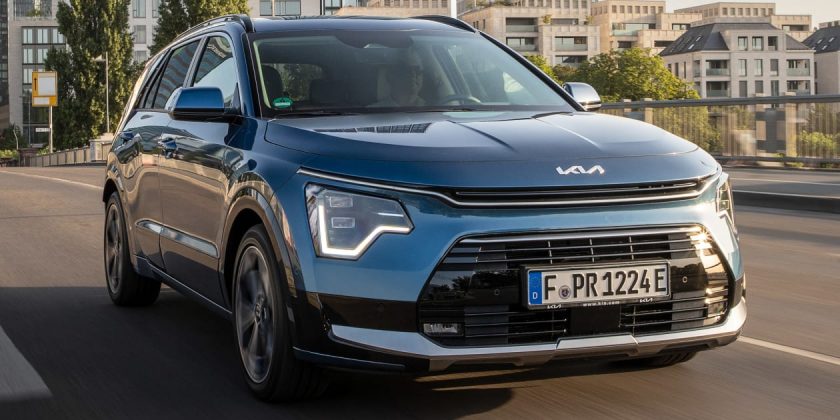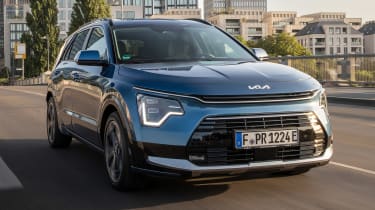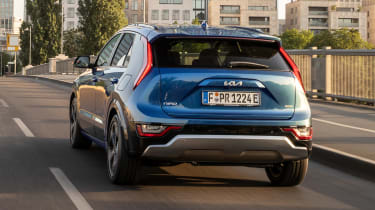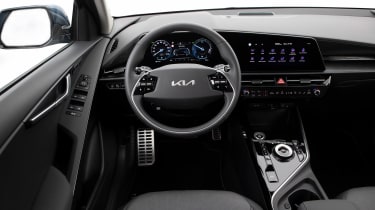The new Kia Niro Plug-in Hybrid promises 180bhp and 279mpg, but how does it fare in the real world?
4.0 out of 5
Buy used for less at Buyacar
Verdict
The new Kia Niro works best as an EV, but the plug-in hybrid version offers a taste of electric car ownership in a comfortable, tech-laden package. It’s a shame that the car’s battery eats into boot space, but the Niro PHEV’s civilised dynamics and spacious cabin make it a front-running family crossover.
The new, second-generation Kia Niro has arrived, and it has quite a task on its hands. For 2022, the Peugeot 2008 rival has been thoroughly overhauled to build upon the success of the original, which thanks to a top notch infotainment set-up, practical interior and compelling price, stood as Kia’s second best-selling model until the end of its life. Riding on the brand’s new K3 platform and featuring tech from the EV6, Kia hopes that the new Niro will carry that momentum forward.
It’s not often that a car spans the entire spectrum of electrification, but the new Niro does. You can order it in conventional hybrid form or as a full EV, with a plug-in hybrid bridging the gap between the two. That’s the one we’re driving here – it’s cheaper than the EV and offers up to 40 miles of quiet, pure-electric running, so it could be the preferred option for those who aren’t willing to commit to electric car ownership, while it’ll also offer a good half-way house for company car drivers that still need to cover longer distances.
New Kia Niro EV 2022 review
- Toyota Yaris Cross vs Kia Niro: 2021 group test review
- Kia Niro PHEV vs MINI Countryman PHEV
- Hyundai Kona Hybrid vs Kia Niro Hybrid
- Kia Niro review
- New Kia Niro EV 2022 review
- New Kia Niro Hybrid 2022 review
- New Kia Niro EV prototype review
- New Kia Niro PHEV 2020 review
New Kia Niro Hybrid 2022 review
Longer, wider and taller than before, the new Niro is far more imposing than its predecessor. There are hints of the firm’s Soul crossover at the front, with a set of LED headlights tucked under a thin chrome-trimmed grille strip. Buyers can specify contrasting paint elements too, which extend to large C-pillar accents along the flanks that double up as aero channels for improved efficiency.
More reviews
Car group tests
In-depth reviews
Road tests
The interior is a marked step up too, with a sweeping dashboard design and soft touch surfaces lifting the ambience. Save for some rougher plastics lower down and a smattering of glossy black trim, the Niro feels like a quality product, and the tech is first rate.
The base-spec Niro 2 PHEV features an eight-inch infotainment screen as standard, but range-topping 4 models receive a dual 10.25-inch screen set-up running Kia’s slick infotainment software. The central screen could be a shade snappier to respond, but the interface is intuitive and the resolution is crisp. The Niro 4 is also fitted with heated rear seats, a powered tailgate, an electric sunroof and an upgraded Harmon Kardon stereo, with all models receiving Apple CarPlay and Android Auto compatibility, too.
The Niro has just about the strongest tech offering in its class, and it retains the versatility of the first-generation car, save for one caveat with the PHEV. The rear seats can easily accommodate tall adults with head and kneeroom to spare, but the plug-in version’s 348-litre boot is smaller than other Niros. The car’s upgraded 11.1kWh battery compared with its predecessor cuts into the load space, which means the PHEV gives up 103 litres to the hybrid version as a result.
Still, the trade-off is much stronger electrical assistance than the conventional hybrid on the move. Both use the same 1.6-litre petrol engine as the previous Niro, but the plug-in hybrid pairs this with a more powerful 83bhp electric motor for a total output of 180bhp.
From a full charge, Kia claims that the Niro PHEV can achieve more than 40 miles of electric-only running and 279.7mpg on the WLTP testing cycle. More than 30 miles of electric drive should be within reach, but don’t expect to achieve anywhere close to the official economy figure in real-world use. As always, plugging in as much as possible will maximise your efficiency.
On its own, the e-motor makes light work of town driving and provides smooth running, but its benefits are also felt at higher speeds. Thanks to the extra electric power, the PHEV provides more effortless performance than the hybrid and takes load off the combustion engine, which is thrashy at high revs and under hard acceleration.
Still, it cuts in seamlessly when required and the six-speed DCT gearbox is relatively smooth, the electric motor helping mask some of the delay when it kicks down. You can take control of the gearbox using the steering wheel mounted shift paddles, but we see little point in this – as a family crossover, the Niro prefers a more relaxed gait.
This is evident in the car’s chassis set-up, which clearly favours comfort over athleticism. The PHEV is actually the best-judged of the three versions – it soaks up harsh road imperfections better than the hybrid, and doesn’t wallow over larger bumps like the heavier Niro EV. The steering is accurate too, with a measured rate of response making it a doddle to place on the road. There is some wind rustle and tyre roar at motorway speeds, but the car feels well isolated on the whole.
If the boot space isn’t a concern, the Niro PHEV offers a compelling blend of comfort, cabin space and tech, and the powertrain is more flexible than the hybrid variant. However, at £33,525, it’s perilously close to the Niro EV’s £36,245 starting price. Given that the pure-electric model has a far bigger boot, zippier performance and better refinement, the PHEV isn’t our preferred flavour of Niro.
| Model: | Kia Niro Plug-in Hybrid 4 |
| Price: | £39,025 |
| Engine: | 1.6-litre four-cylinder petrol plug-in hybrid |
| Power/torque: | 180bhp/265Nm |
| Transmission: | Six-speed dual-clutch automatic, front-wheel drive |
| 0-62mph: | 9.8 seconds |
| Top speed: | 100mph |
| Fuel economy: | 279.7mpg |
| CO2: | 23g/km |
| On sale: | Now |
Next Steps
Source: Read Full Article



 New Kia Niro EV 2022 review
New Kia Niro EV 2022 review
 New Kia Niro Hybrid 2022 review
New Kia Niro Hybrid 2022 review